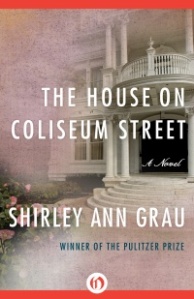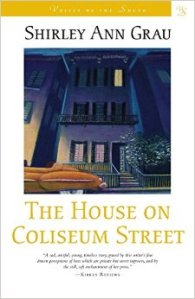 When it comes to American novels, I prefer Southern. I love the mix of heat, humidity, and Gothicism.
When it comes to American novels, I prefer Southern. I love the mix of heat, humidity, and Gothicism.
I have just discovered Pulitzer Prize-winning Shirley Ann Grau.
Grau’s The House on Coliseum Street, set in New Orleans, has a cast of Southern eccentrics. The house is full of women: 20-year-old Joan Mitchell, her three half-sisters, and her mother Aurelie Caillet, who has been married five times. Aurelie’s current husband also lives there–until he is carted off to a mental hospital.
Characterized by a gorgeous style, realism, and a slight Gothicism, this novel is a gem.
 The House on Coliseum Street (1961) is a classic. It is also an astonishing Southern novel about abortion. In the ’60s, no one in the South talked about abortion. After her abortion, the heroine, Joan, numbed by the secrecy, goes mad in the style of the narrator of Shirley Jackson’s We Have Always Lived in the Castle is. Okay, she doesn’t go as far as Cordelia, but she goes pretty far.
The House on Coliseum Street (1961) is a classic. It is also an astonishing Southern novel about abortion. In the ’60s, no one in the South talked about abortion. After her abortion, the heroine, Joan, numbed by the secrecy, goes mad in the style of the narrator of Shirley Jackson’s We Have Always Lived in the Castle is. Okay, she doesn’t go as far as Cordelia, but she goes pretty far.
The novel opens after the abortion, when Joan is waiting for her mother to pick her up. She has been banished to her great-aunt’s house on the Gulf coast, so no one in New Orleans would know. It is so taboo among upper-class Southerners that her great-aunt insists that Joan go to a dance the night before the abortion so one will suspect. Joan got pregnant by Michael, a handsome professor who used to date Joan’s younger sister and asks her out on a whim.
Joan contentedly watches the rain from the gazebo as she waits for her mother, but does not want to return to the house on Coliseum Street. Built by her great-great-great grandfather, it is supported by funds from Joan’s late father, on the condition that a particularly hideous fountain he designed remain in the front yard.
She didn’t want to go home. Maybe because she had the funniest feeling that the house wasn’t real, wasn’t there at all. Nor the people in it…she felt different here on the coast. Not happy, perhaps. But sure. She hadn’t been this sure since she was a child and had gone into the library (a small dark room, its air laced by the carbolic smell of bindings and the sweet odor of mildew, and in a little secretary , carefully locked against the children, the family-written books…)
Nothing is real to Joan because the abortion is a secret. And, typically, her mother denies it by arriving at the great-aunt’s with Joan’s sometimes boyfriend, who knows nothing about the abortion or even her date with Michael.
When she gets home, she reads. She has always been a reader. She takes college courses to get out of the house, and chooses her classes at random. (She does not even know her schedule.) She works in the library, in a kind of attic where she is supposed to fill orders for books that are rarely requested. And she is obsessed with Michael, who takes her out once at her suggestion. He obviously has no interest in her, and she thinks the abortion has made her repulsive.
It takes so long to grow back, she thought; I didn’t know they were going to have to shave there. But I didn’t know anything about it. And anyway, as soon as the hair grows back, there won’t be a mark to show that it ever happened. Not a mark. And nobody will know.
Completely solitary, speaking to almost no one, she is breaking down. But it is the secrecy that has done it. She had fancied herself a mother–the pregnancy might fill her emptiness. She was so passive that her mother made the decision for her.
No wonder she is angry–and more than a little crazy. She stalks Michael and his young girlfriend. And…
Before Roe v Wade, abortion was taboo in the South.
The novel is in print by Louisiana State Press and as an e-book by Open Road Media.

A novelist I hadn’t heard of – so thank you for introducing her to me. We don’t seem to hear so much about Pulitzer prize winners over here.
LikeLike
The Pulitzer is one of the big prizes here, and they’re worth checking out. Honestly,she is a very good writer. I found out about her from Jonathan Yardley’s book, Second rEading.
LikeLiked by 1 person
I love the sound of this, though I suspect hard to get in the UK.
LikeLike
Maybe the e-book!
LikeLike
I will look on the open media though 🙂
LikeLike
Good luck!:)
LikeLiked by 1 person
Thank you. I want to tell of an antidote: Katha Pollitt has just published _Pro: Reclaiming Abortion Rights_. Reviewed by Marlene Fried in the recent WRofB, Pollitt’s argument is we must reframe the way people are pressured into thinking about abortion. Abortion is a social good; seen in its full human setting, it’s not a tragedy, a social or necessary evil; ending an unwanted pregnancy is a common, and should be seen as a normal event, part of the reproductive lives of women. No one really believes a human being is there at conception, if they did, they would be upset when a zygote is lost, feel just as bad about embryos being lost as people in a burning building. It’s religious and other authority figures who want to control women who insist on this shaming, stigmatizing, silencing. The silence is the worst part of it as that keeps us this idea of self-loathing, the surroundings that make the woman feel some terrible thing has happened. The dominance of men in sexual relationships prevents them from preventing pregnancy. The concern should be the woman — is this fiction about a fetus? no. That no one should have the right to use her body against her will or control it.
What year was the book written and published?
LikeLike
The book was published in 1961. It’s really fascinating–one of the great abortion novels! The poor woman is driven literally crazy by the abortion, but it is also her family. Her mother does not even tell her sister. It is silence and shame.
I am sure Pollitt wrote an intelligent book. I used to read her column in The Nation (which I stopped subscribing to).
Keep abortion safe and legal! as we used to say the ’70s. They’re probably still saying it today.
LikeLike